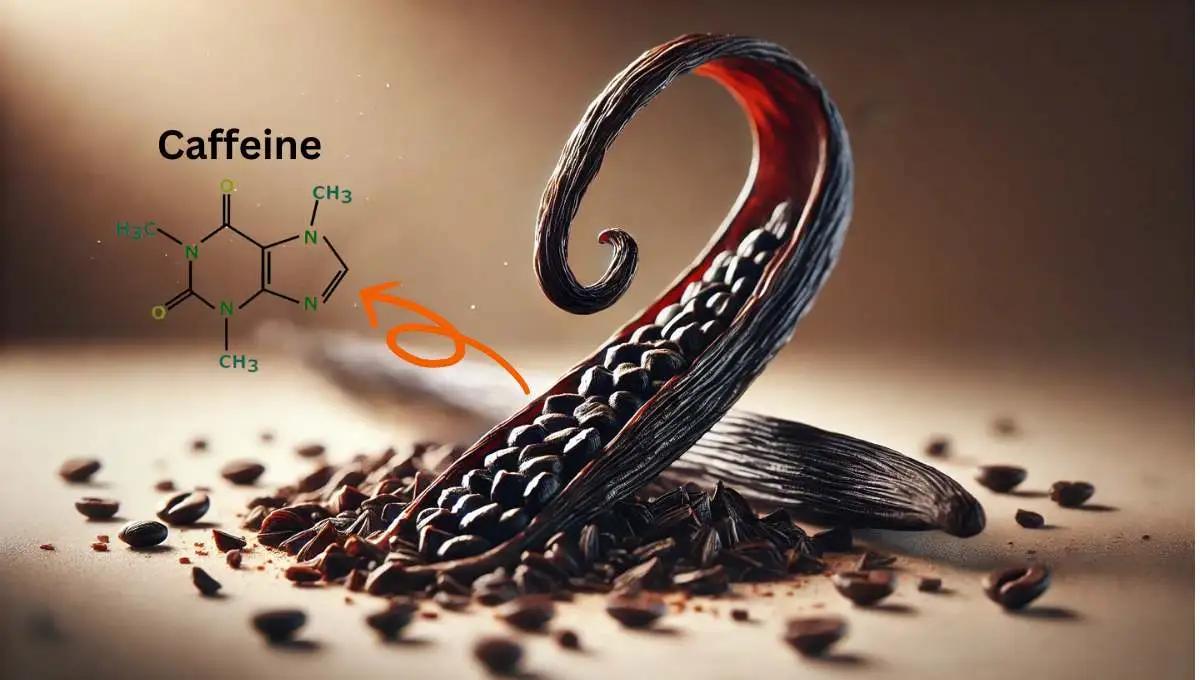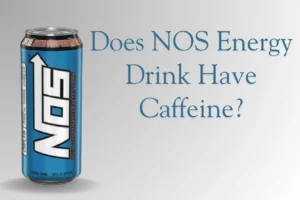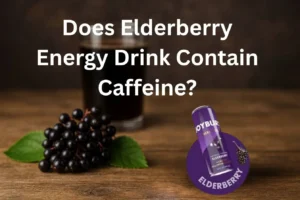Vanilla bean is one of those popular treats that truly stand out. Whether it’s used in desserts or beverages, its rich, vibrant flavor and sweet aroma are loved by many. You might be wondering if vanilla bean carries any caffeine like other plant-derived treats such as coffee or chocolate. The truth is that vanilla beans don’t contain caffeine.
They come from the cultivated seed pods of a tropical orchid, and these beans are sought-after for their complex, medicinal qualities. While they do have some stimulating properties, they don’t provide the same energizing boost as caffeine does. So, if you’re looking for that extra pick-me-up, vanilla bean can be a delightful addition to your treats, but it won’t give you the same caffeine kick.
The aroma of vanilla is energizing, and it still enhances the experience with its beloved scent, but it’s caffeine-free. Vanilla bean offers comfort and warmth in its flavor but doesn’t deliver the same effect you might get from coffee or chocolate.
What Is Vanilla Bean?
Vanilla bean comes from the pods of orchids in the genus Vanilla, specifically Vanilla planifolia. These beans are carefully cultivated, cured, and processed to bring out the aromatic flavor that is widely used in cooking, baking, and various beverages.
The rich flavor and sweet essence of the vanilla bean are highly valued in the culinary world, adding depth to a wide range of treats. While these beans do not contain caffeine, their complex and delightful flavor still makes them a favorite in many recipes around the globe.
Fun Facts About Vanilla Bean!
Does Vanilla Bean Have Caffeine? The Facts
No, vanilla beans do not naturally contain caffeine. Vanilla is derived from orchids and provides a distinct flavor, but it is not a stimulant like caffeine. Caffeine is found in coffee, tea, and some sodas, but not in vanilla beans.
Vanilla bean is naturally caffeine-free because it comes from a plant that does not produce caffeine. Many people experience confusion due to the way vanilla is often paired with other products like coffee or energy drinks that do contain caffeine. In its pure form, vanilla bean is free of any caffeine, offering a complex, sweet, and comforting flavor profile.
The flavor comes from organic compounds, mainly vanillin, and has no relation to the stimulating properties of caffeine. So, while vanilla might be used in items that contain caffeine, the truth is that vanilla beans themselves are completely caffeine-free.
The Sweetness Factor
Vanilla-flavored treats like desserts and beverages are often seen as indulgent because of their sweet and comforting taste. However, many people mistakenly believe that since these treats are sometimes associated with ingredients like coffee or chocolate, they must also contain caffeine.
This connection often leads to a false assumption that vanilla itself acts as a stimulant. In reality, the sweetness of vanilla doesn’t come with any caffeine, and it’s just the flavors it’s paired with that may contain it.
Misleading Products
While commercially produced vanilla-flavored items may seem like a safe choice, it’s important to note that some may contain additional caffeine from other ingredients. It’s essential to always check the ingredient lists carefully to ensure that you’re not consuming something unexpected.
Even though vanilla itself is naturally caffeine-free, understanding the products you buy allows you to make informed decisions about your food and drink choices. If you are someone who wants to limit or avoid caffeine, knowing that vanilla has no caffeine can help.
It’s a confident and safe flavor for individuals with sensitivities or medical restrictions who wish to enjoy its delicious flavor without any worry.
Importance of Knowing Caffeine Content in Vanilla Bean
Understanding the caffeine content in vanilla bean is important, especially for individuals who are sensitive to caffeine or those who may have health conditions requiring caffeine restriction.
Vanilla bean, derived from the meticulously cultivated orchid Vanilla planifolia, is a prized culinary ingredient known for its sweet, warm, and complex flavor profile, but it doesn’t carry significant caffeine like coffee or chocolate.
If you’re pregnant, breastfeeding, or have a medical condition, knowing the caffeine content is crucial for managing your overall intake, avoiding dependence, and reducing withdrawal symptoms.
As vanilla bean is a common flavoring agent in both culinary and beverage products, having accurate knowledge about its caffeine contribution is key for health-conscious consumers and manufacturers alike.
Whether you’re making dietary choices or formulating products for a specific audience, understanding the potential presence of caffeine can help you make informed decisions. Despite its medicinal qualities historically valued by ancient Mesoamerican civilizations, vanilla bean remains a safe and enjoyable ingredient, provided it’s consumed in moderation.
Why the Confusion?
There is often a misconception that vanilla bean contains caffeine, but this usually comes from its use in caffeinated products like coffee or energy drinks. For example, vanilla lattes and vanilla-flavored cold brews contain caffeine, but the source of caffeine is the coffee, not the vanilla bean itself.
Similarly, some teas that are infused with vanilla may also contain caffeine due to the tea leaves, not the vanilla flavoring. This confusion arises because vanilla is often paired with ingredients that naturally contain caffeine, but the vanilla bean alone does not contribute to the caffeine content.
Vanilla Bean Variants and Their Caffeine Content
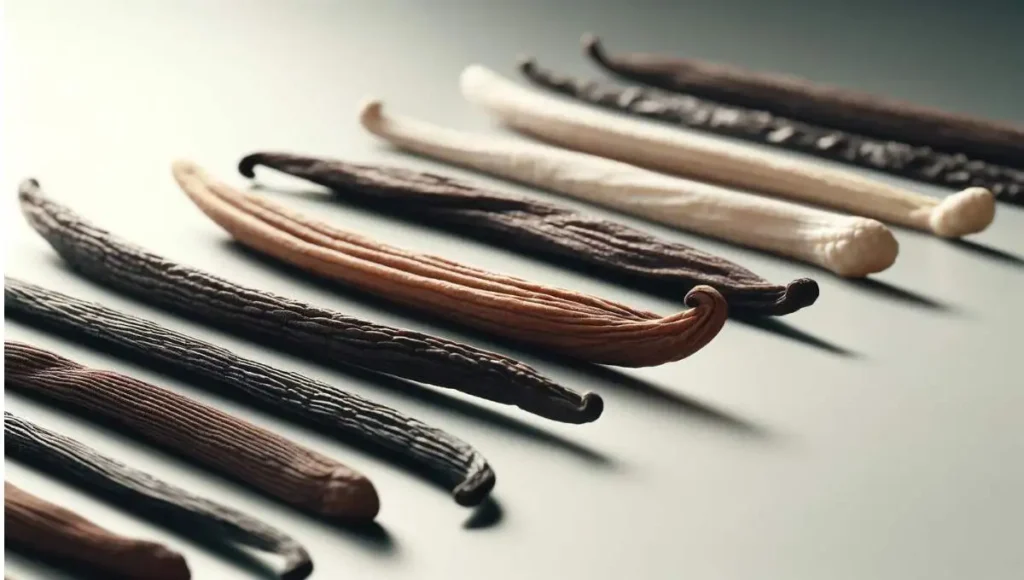
There are many varieties of vanilla beans, each offering a distinct flavor and unique properties. While these beans are popular in both desserts and beverages, they all share the common characteristic of being caffeine-free.
Their flavor can vary depending on the set of properties they bring to the table, but none of these variations contain caffeine, making them a perfect choice for those who wish to savor the taste without experiencing the stimulating effects of caffeine.
Madagascar Vanilla Beans (Caffeine-free)
Madagascar vanilla beans are often thought to be the benchmark for vanilla flavor, prized for their rich, creamy flavor with sweet and floral notes.
These vanilla beans have become synonymous with high-quality vanilla, offering a distinctive and aromatic essence. Despite their wonderful taste, they are caffeine-free, so you can enjoy their delicious flavor without worrying about any caffeine content.
Tahitian Vanilla Beans (Caffeine-free)
Tahitian vanilla beans are well-known for their distinctive floral aroma and delicious flavor, which makes them highly sought-after. Unlike other varieties, they have subdued tastes with licorice and cherry undertones, making them perfect for adding complexity to desserts and even perfumes.
Importantly, just like other vanilla beans, Tahitian beans are naturally caffeine-free, offering all the vanilla flavor you crave without any caffeine concerns.
Mexican Vanilla Beans (Caffeine-free)
Mexican vanilla beans are renowned for their robust and spicy flavor, featuring distinctive undertones of nutmeg and cinnamon. These beans are especially good at enhancing the flavor of both savory and sweet foods, adding a layer of nuance and complexity to dishes.
Like all vanilla beans, Mexican vanilla beans are naturally caffeine-free, offering rich and exciting flavors without any of the stimulating effects of caffeine.
Ugandan Vanilla Beans (Caffeine-free)
Ugandan vanilla beans are gaining popularity for their bold and robust flavor, making them a favorite among chefs and bakers. Known for their intense flavor profile, these beans add a rich, full-bodied taste to a wide variety of recipes.
Despite their strong flavor, Ugandan vanilla beans are caffeine-free, offering a vibrant flavor without the stimulating effects associated with caffeine.
Indonesian Vanilla Beans (Caffeine-free)
Indonesian vanilla beans are recognized for their unique smoky and woody flavor profile, often accompanied by subtle hints of chocolate and tobacco.
Despite their complex and aromatic flavors, these beans are caffeine-free, offering a rich vanilla experience without any stimulating effects. Whether used in desserts or beverages, Indonesian vanilla beans add depth without the worry of caffeine intake.
Indian Vanilla Beans (Caffeine-free)
Indian vanilla beans are known for their bold, woody, and spicy flavor. They add a unique depth to both savory and sweet dishes, making them ideal for a variety of recipes. The flavor profile of Indian vanilla is strong and perfect for those looking for a more intense vanilla taste.
Despite their powerful flavor, it is important to note that Indian vanilla is caffeine-free, so you can enjoy its rich taste without worrying about any stimulating effects.
West Indian Vanilla Beans (Caffeine-free)
West Indian vanilla beans are known for their sweet and floral flavor, making them a popular choice for light and fruity desserts or tropical cocktails. Their delicate taste and mild vanilla flavor make them perfect for recipes that call for a more subtle vanilla profile.
These beans are highly suitable for those who want a perfect balance in flavor, without worrying about the presence of caffeine, as they are completely caffeine-free.
Papua New Guinea (PNG) Vanilla Beans (Caffeine-free):
PNG vanilla beans are known for their unique flavor profile, which is influenced by the ideal growing conditions of rich soil and abundant sun. These beans are becoming increasingly popular among chefs for their distinct taste, providing a flavor that stands out.
Just like other vanilla beans, PNG beans are completely caffeine-free, allowing you to enjoy their delicious taste without any caffeine content.
Tongan Vanilla Beans (Caffeine-free):
These beans are known for their sweet, mellow, and creamy profile, making them ideal for a wide range of recipes. Whether it’s for sweet desserts or savory dishes, their smooth and creamy flavor adds versatility to many culinary uses.
Like all vanilla beans, they are naturally caffeine-free, ensuring you can enjoy their rich flavor without worrying about caffeine content.
- Does NOS Energy Drink Have Caffeine? Expert Guide (2025)
- Does Bubbl’r Sparkling Water Have Caffeine? Full Breakdown In 2025
- Does Elderberry Energy Drink Contain Caffeine? Complete 2025 Review
Common Vanilla-Infused Products and Their Caffeine Content
Below table is showing the common vanilla infused products with their caffeine content.
| Product Name | Caffeine Status | Source Notes |
| Vanilla Bean Powder | No | Pure vanilla bean ground into powder |
| Vanilla Latte | Yes | Coffee or espresso base |
| Vanilla Extract | No | Typically made with alcohol, not caffeine |
| Vanilla Coke | Yes | Carbonated soda with added caffeine |
| Vanilla Tea (e.g., chai) | Yes | Tea leaves or added caffeine |
| Vanilla Bean Ice Cream | No | Not applicable |
Nutritional Profile and Ingredients of Vanilla Bean
Vanilla beans, from the Vanilla planifolia orchid, are primarily a flavoring agent with a modest nutritional profile. Per 100g of dried beans, they offer about 288 calories, 12.65g carbs, 19.6g fiber, and negligible fat and protein. They contain trace B-vitamins (e.g., riboflavin) and minerals like manganese, potassium (~16.2%), and calcium (~19.7%), though these are rarely consumed in significant amounts.
Their key “ingredients” are natural compounds: vanillin (1-2%), the main flavor source with antioxidant potential, plus sugars, essential oils, and over 300 aromatic compounds like eugenol and esters, developed during curing. Used sparingly, vanilla beans contribute more to taste than nutrition.
List of Ingredients in Vanilla Bean
Vanillin
The flavor of vanilla beans comes from a variety of natural ingredients, with vanillin being the main ingredient responsible for its distinctive flavor.
Ethyl Vanillin
This compound is joined by ethyl vanillin, an aromatic molecule that enhances the overall flavor profile of vanilla.
Piperonal
Piperonal, another compound found in the beans, adds subtle spicy notes to the aroma.
Water
In addition to these, vanilla beans contain water, which provides moisture, helping them stay plump and fresh.
Cellulose
The structure of the bean itself is made up of cellulose, a plant-derived polysaccharide that forms part of its structural framework.
Lignin
Along with cellulose, lignin is another important structural component of the vanilla bean.
Minerals
Depending on where the vanilla is grown, there may be trace amounts of minerals, which come from the soil and the growing conditions.
Volatile Compounds
Finally, various volatile compounds contribute to the overall aroma, adding to the complexity of the vanilla experience.
Despite these varied components, it is clear that vanilla beans are free from any caffeine, as none of these ingredients are stimulants.
Vanilla Bean Nutritional Information
A single vanilla bean pod (approximately 0.5 grams) is incredibly low in calories, containing only about 1.4 calories. It offers zero fat (saturated, polyunsaturated, and monounsaturated ), cholesterol, and sodium.
Vanilla beans also contain negligible amounts of carbohydrates, dietary fiber, and sugar. It provides trace amounts of certain minerals like calcium, iron, and potassium. Importantly, vanilla beans are naturally caffeine-free.
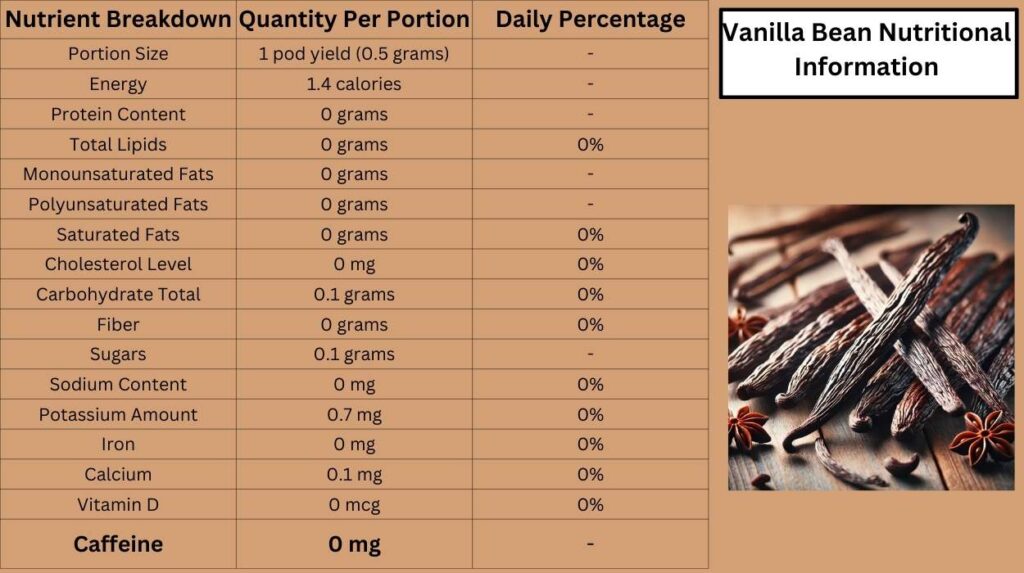
Benefits of Vanilla Bean
Vanilla bean is a naturally caffeine-free ingredient that offers a host of impressive health benefits. This delightful spice is rich in antioxidants, such as vanillin, a compound known for its strong antioxidant properties.
These compounds help reduce oxidative stress, which is linked to various chronic conditions. For those seeking to enjoy a comforting and flavorful experience without the jitters from caffeine, vanilla bean is a perfect choice. It’s a great addition for health-conscious individuals who want to embrace both flavor and wellness in their daily lives.
Mood-Enhancing Effects
The scent of vanilla bean has long been celebrated for its ability to create a calming atmosphere. Whether you’re using vanilla in a warm beverage or as a natural extract, it can have uplifting effects on your mood, helping to reduce anxiety and create a sense of peace.
Its subtle sweetness, combined with the calming aroma, makes it an ideal choice for those seeking mental clarity without the stimulating effects of caffeine.
Low-Calorie, Versatile Flavor
In addition to its health perks, vanilla bean is a low-calorie option, making it a guilt-free indulgence for those watching their calorie intake. Its ability to bring out rich flavors in both sweet and savory dishes makes it an incredibly versatile ingredient.
It’s perfect for anyone who wants to add a natural, flavorful touch to their meals or drinks without adding excess sugar or artificial ingredients. Vanilla bean’s natural sweetness allows you to enjoy a satisfying treat while staying aligned with a health-conscious approach.
Alternatives to Vanilla Bean With Their Caffeine Content
When seeking alternatives to vanilla beans, you’ll find that some options offer warmth, sweetness, and complementary notes similar to the original, while others might contain caffeine. Pure vanilla doesn’t have caffeine, but extracts or coffee-based vanilla options can.
As someone who enjoys experimenting with flavors, I’ve learned that choosing the right alternative can create the perfect flavor balance in recipes without the added intricacies of caffeine.

Tonka Beans
If you’re looking for a unique substitute for vanilla bean, consider tonka beans, which contain coumarin, a compound that provides a distinct aroma. This aroma combines elements of vanilla, almond, sweet cherry, and caramel, with a hint of spice.
These beans make a wonderful addition to custards, ice creams, and various other desserts, adding complexity and depth to the flavor profile. While tonka beans offer an intriguing alternative, they don’t contain caffeine, making them a great choice for those seeking a rich flavor without the added stimulant.
From my experience, using tonka beans in desserts creates a satisfying flavor experience that enhances the overall dish.
Cassia Bark:
Cinnamon is a more readily available option that brings a familiar warmth and sweetness with a similar undertone to vanilla, but it also carries a hint of spiciness. This spice works wonderfully in baked goods, enhancing the flavor and adding depth to warm beverages.
As someone who enjoys experimenting with different spices, I’ve found that cinnamon adds a delightful balance to desserts and drinks without introducing any caffeine.
Almond Extract
Almond brings a sweet, nutty essence that wonderfully complements the subtle nutty notes found in vanilla. While offering a warmth similar to vanilla, it should be used cautiously in baking, desserts, and even savory dishes to avoid overwhelming the dish.
Personally, I’ve found that almond’s unique flavor adds a depth of taste without any hint of caffeine, making it an ideal choice for those seeking a mild, vanilla-like warmth in their recipes.
Maple Syrup
Maple syrup offers a rich, distinct flavor that brings sweetness and a hint of caramel, making it a great choice to complement baked goods and sauces. While it’s not a perfect match for vanilla, it can serve as a partial replacement in recipes like pancakes, waffles, or sweet bread.
I’ve personally found that using maple syrup in place of vanilla adds a delightful, unique twist to dishes without any concerns about caffeine.
Honey
Honey is a natural sweetener that brings out beautiful floral notes, and if you choose varieties with warmer, amber tones, it can offer a flavor profile closer to vanilla. It enhances the taste of baked goods, oatmeal, and can even be drizzled over yogurt or fruit for an extra touch of sweetness.
From my experience, honey’s rich flavor adds a gentle vanilla-like warmth to many dishes without introducing any caffeine.
Vanilla Paste
Vanilla paste is the best approximation of real vanilla, made from vanilla beans. It contains the tiny specks characteristic of pure vanilla, making it an excellent choice when you need a rich, authentic flavor.
You can substitute it in most recipes where vanilla bean is required, offering a similar taste without worrying about the presence of caffeine. From my own experience, vanilla paste has become a favorite alternative, especially for its ease of use and consistent flavor in desserts and baked goods.
Dried Coconut
Toasted coconut provides a subtle sweetness with tropical undertones and adds an extra dimension to recipes. It works well as a partial substitute for vanilla in certain cookies, granolas, or desserts.
From personal experience, I’ve found that toasted coconut enhances the flavor profile without introducing any caffeine, making it an ideal alternative for those looking to avoid stimulants while still enjoying rich flavors.
Rose Water
Floral essence offers a delicate aroma and can be used sparingly for a subtle, perfumed note that complements the floral hints found in vanilla. It’s particularly effective in delicate cakes and custards, adding a unique twist without any concerns about caffeine.
From my own experience, this essence brings a refined, light touch to desserts, offering a lovely alternative when you’re seeking something more aromatic.
Orange Blossom Water
Orange blossom water is similar to rose water, offering a delicate citrusy-floral aroma that works best when used sparingly. Its delicate notes can enhance other flavors in specific recipes, adding a touch of elegance without overpowering the dish.
I’ve personally enjoyed using it in cakes and desserts, where its light flavor profile complements vanilla without introducing any caffeine.
Saffron
Saffron is a precious and expensive spice that provides a complex flavor with earthy, floral hints and a subtle, honey-like sweetness. You only need a few threads for very special recipes, where a unique, luxurious depth of flavor is desired.
From my experience, saffron offers a distinct, rich taste, perfect for those seeking something sophisticated without any concerns about caffeine.
| Ingredient Option | Caffeine Presence |
| Maple Syrup | Caffeine-free |
| Saffron Threads | Caffeine-free |
| Cassia Strips | Caffeine-free |
| Rose Essence | Caffeine-free |
| Honey Drizzle | Caffeine-free |
| Almond Infusion | Caffeine-free |
| Vanilla Blend | Caffeine-free |
| Orange Flower Water | Caffeine-free |
| Tonka Pods | Caffeine-free |
| Coconut Flakes | Caffeine-free |
Conclusion
Vanilla bean is naturally caffeine-free, making it a versatile and safe choice for those avoiding caffeine. While many vanilla-flavored products might contain caffeine due to ingredients like coffee or tea, vanilla extract and pure vanilla bean offer a delicious and complex flavor profile without any stimulating effects.
These can easily be used in desserts, drinks, and even some savory dishes to add warmth and sweetness. If you’re craving a cozy vanilla latte or a sweet vanilla cookie, you can enjoy the classic flavor guilt-free, knowing it’s a naturally caffeine-free indulgence. From my personal experience, I’ve found that vanilla offers a perfect balance of flavor without the concern of caffeine consumption.
FAQs
Does Starbucks vanilla bean frappuccino have caffeine?
Vanilla bean frappuccinos are made with a cream base instead of a coffee base, meaning there is no caffeine in them. This makes them a great option for those looking to enjoy the flavor of vanilla bean without the stimulating effects of caffeine.
Does vanilla keep you awake?
Vanilla’s sedative benefits are so powerful that it can help lower blood pressure and make you feel drowsy, allowing you to drift into a faster, more relaxing sleep. It’s a great option if you’re seeking relaxation without the worry of caffeine keeping you up.
Does vanilla powder have caffeine?
New York vanilla bean powder is non-GMO and caffeine free, making it a delicious ingredient for flavoring foods and baking. You can use it to enhance your recipes without worrying about any caffeine content, enjoying all the rich vanilla flavor it brings to your dishes.
Does Tim’s French vanilla have caffeine?
This drink contains milk and caffeine, so it is not a dairy-free or caffeine-free alternative. If you’re looking for a drink without caffeine or dairy, unfortunately, this option doesn’t provide that.
Why is vanilla so addictive?
The British Medical Journal states that vanilla can be highly addictive. The active ingredient in vanilla is linked to epinephrine and norepinephrine, also known as adrenaline and noradrenaline. This connection makes vanilla more intriguing than just its flavor, with some potential effects related to the body’s response to stimulants, though it doesn’t involve caffeine directly.

